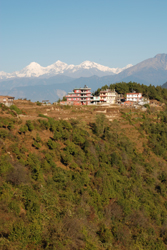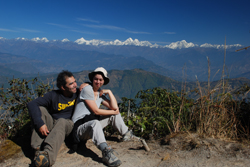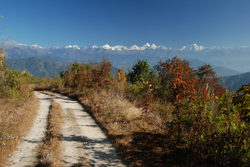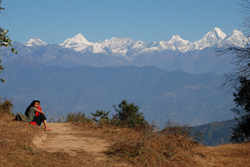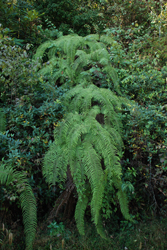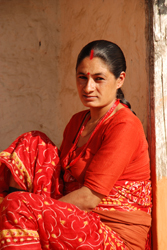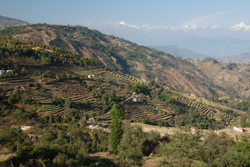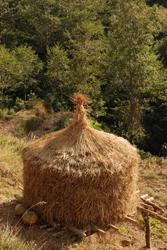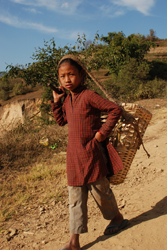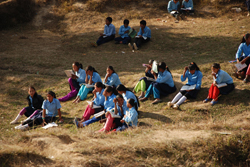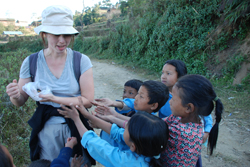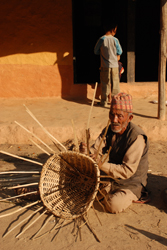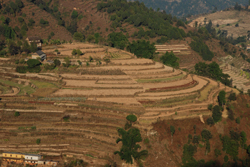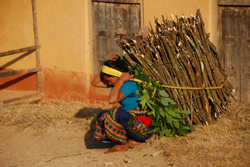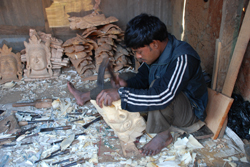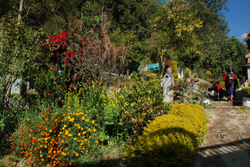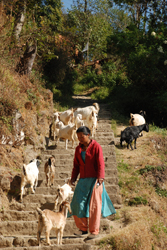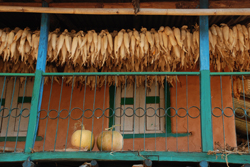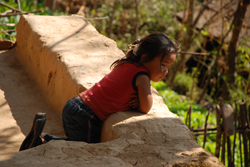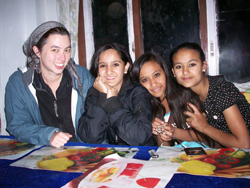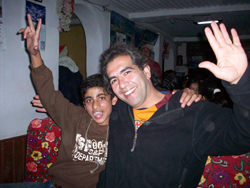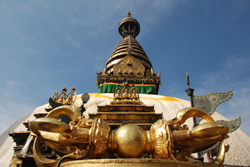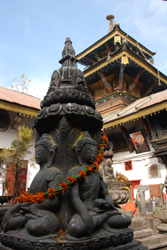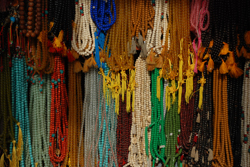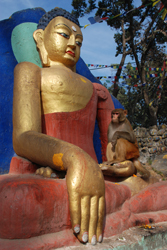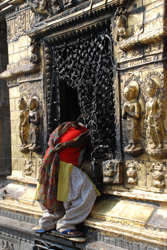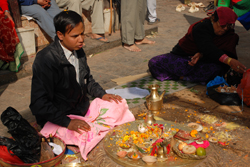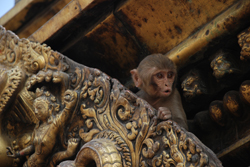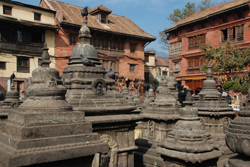Nagarkot Trek Day 2: To Nagarkot: DO NOT FEED THE CHILDREN
30 November, 2008, 12:23 am in "Nepal"
Even after their prank attempt of the previous night, the girls still managed to get up about ½ hour before us and fill the hall with voices and footsteps. We got up at 6 and emerged into a hall filled with boys and girls walking back and forth brushing their teeth.
The clouds that had covered them mountains at dusk the night before had disappeared leaving the mountains shining like a diamond necklace in the sky. The sun hadn't risen yet but was filling the Eastern sky with shades of rose and gold.
One of the amazing things about the Himalayas is how they just seem to stretch on and on forever, mountain range after snow crowned mountain range. From Chisopani, the snow capped peaks seemed to run off into the the East until they faded into blue shadows, mountains obscured by distance and smog. To the West, they disappeared obscured by some trees only to reappear on the other side once again disappearing from view behind some closer hills. Even from our height of 2000 meters, the mountains seem to float above us in the sky. The hills below were obscured by smog hiding the mountains connection with the earth. The valley dropped below us with terraced hillsides like a living contour map.
We had to wait for the sun to rise a bit from behind the mountains in the East before the pink light touched the tops of the rest of the mountains and gradually crept over the snow covered peaks. Shisher joined us and pointed out the different ranges: Annapurna to the West, then Manaslu (where the village where he grew up is located), and Ganesh Himal.
We had to wait for the sun to rise a bit from behind the mountains in the East before the pink light touched the tops of the rest of the mountains and gradually crept over the snow covered peaks. Shisher joined us and pointed out the different ranges: Annapurna to the West, then Manaslu (where the village where he grew up is located), and Ganesh Himal.
It was a beautiful morning for hiking-- crisp and cool but with a clear blue sky and a warm sun. The path followed the side of a small mountain and most of the time we walked parallel to the Himalayas which soared above the green terraced valleys.
There was a cool dampness in the shade which produced a wealth of green trees and bushes. Light green ferns draped themselves over trees looking like a giant feather boas. As we descended a little into the valley, we left the forest and approached a more settled area.
The atmosphere became more cheerful with cultivated patches of flowers adding more color and cows, buffalo, goats and chickens adding their voices and movements to the scene. Women in bright colored clothing washed more bright colored clothes by a stream or did other chores. The houses were adorned with bunches of corn hanging to dry from the eves and balconies. The terraced fields were neat and organized compared to the chaotic greens of the forest.
We stopped in the village of Chauki Bhanjyang for lunch at a restaurant owned by someone who originally came from the same town as Shisher. The village was at the crossroads of a foot path and the road. There was a hotel and a couple shops. Chickens, dogs and goats wandered the streets. Occasionally a truck would roll by sending a cloud of dust up. In front of one of the hotels, someone played a guitar.
We had dal bhat which, though similar to the dal bhat of the night before, had a different curry containing greens and potatoes as well as a different mix of lentils (dal). Dal bhat is the quintessential Nepali food. It is literally translated as “lentils and rice”. Usually it includes a huge pile of rice, a bowl of lentil soup, potato curry, and a “papad” (like a giant spiced tortilla chip). Sometimes it contains some greens as well. Though eating it would seem to be redundant, many places prepare it slightly differently so you can get away with eating it quite frequently.
From there we walked along the road through other villages with haystacks looking like beach bungalows on a tropical island. There were clusters of bamboo and banana trees. We walked through a village called Jahar Sinpauwa. There was a school in session outside and teenagers in school uniforms sat reading in the sun. It seems whenever we pass a school building there is a mess of noise emanating from it. However, out in the open air, everyone seemed to be peacefully concentrating on their studies.
We had dal bhat which, though similar to the dal bhat of the night before, had a different curry containing greens and potatoes as well as a different mix of lentils (dal). Dal bhat is the quintessential Nepali food. It is literally translated as “lentils and rice”. Usually it includes a huge pile of rice, a bowl of lentil soup, potato curry, and a “papad” (like a giant spiced tortilla chip). Sometimes it contains some greens as well. Though eating it would seem to be redundant, many places prepare it slightly differently so you can get away with eating it quite frequently.
From there we walked along the road through other villages with haystacks looking like beach bungalows on a tropical island. There were clusters of bamboo and banana trees. We walked through a village called Jahar Sinpauwa. There was a school in session outside and teenagers in school uniforms sat reading in the sun. It seems whenever we pass a school building there is a mess of noise emanating from it. However, out in the open air, everyone seemed to be peacefully concentrating on their studies.
Further on, Rowshan stopped to take some photos of a group of kids who excitedly demanded a photo. After giggling over the photo they started demanding, “Chockla Chockla!” (“candy” a bastardization of “chocolate”) Rowshan called me over and asked me to get out our nuts and raisins from our bag. Now, one is not supposed to give children treats because it teaches them to beg, and I know this. However, I stupidly pulled out the plastic bag and opened it, half expecting them to run off in disgust seeing it didn't contain candy. However, at the sight of the open bag, the kids crowded around me with dirty hands grabbing. One girl grabbed two handfulls before I realized I needed to do the distribution myself. It felt like a scene from a horror film where I was about to be torn apart by miniature zombies who instead of crying, “Brains! BRAINS!” cried, “Chockla! Chockla!”
We managed to escape their clutches but they pursued Rowshan quite a ways down the road crying, “CHOCKLA! CHOCKLA!” Begging is a huge problem in Nepal. The entry card we filled out to get our visa even requests, “Do not encourage begging by being benevolent.” Children everywhere request candy, money, and pens. They may not know any other English except, “Hello. Give me pen (money, rupee, chockla)” Lonely Planet and other “responsible travel” organizations request that travelers refrain from giving things to children because it encourages them to beg. The pen begging is an interesting example of this. I remember, when I first started traveling on my own, reading the advice of giving children pens, notebooks and school materials instead of candy. That was perhaps 15 years ago and I have had the opportunity to see how this piece of advice went horribly wrong. The current PC thing to do is donate to organizations instead.
Back on the road, we passed a basket weaver and many people who thankfully just went along doing their daily business. As we walked into Nagarkot we saw a man carving wooden masks. Nagarkot is on the top of a hill covered with pine trees. Its a resort town with tons of hotels but more importantly a fabulous view of the Himalayas and the valley.
Back on the road, we passed a basket weaver and many people who thankfully just went along doing their daily business. As we walked into Nagarkot we saw a man carving wooden masks. Nagarkot is on the top of a hill covered with pine trees. Its a resort town with tons of hotels but more importantly a fabulous view of the Himalayas and the valley.
Nagakort Trek Day 1: To Chisopani: Peaceful Mountains
29 November, 2008, 02:46 am in "Nepal"
The minibus to Sundariyal left before it was full which surprised me, but I figured it would pick up people on the way... which it did. The conductor, a boy of about 12, stood at the entrance puffing a cigarette waiting for people to board. He shouted out the names of the towns the bus went through and, as the bus was soon full with people hanging out from the door, was soon crawling all over the outside-- banging on the sides, popping his head through the back window to make people move back, or directing people to sit in an empty seat. At one point a jolly looking man boarded the bus. He had a large paunch and wore red satin robes, and interesting wood shoes-- just the sole and a big wooden piece that went between the large and 2nd toe with a huge knob to hold it. He had big curly hair and when he spoke to the conductor he wagged his head making his curls bounce and reminding me of a comic character in a Bollywood film. Rowshan asked him if he could take a photo but he responded “God bless. God bless. No photo.”
Eventually we reached the countryside. The buildings that lined the street gave way to views of fields and hills. We got off at the last stop and started walking up a small path, mostly made of stone steps. We rose through the village past small shops and some food places. Goats and their kids wandered across the paths bleating and chickens clucked and scratched. People climbed the steps carrying heavy loads in baskets.
Higher up the houses were a little more spaced out but still appeared in village clusters. The walls were painted bright colors-- light blue, peach, and green. Over many of the doorways were dried marigold garlands. Others had ears of corn drying in the eves. Often from the trail we had views of the hills with terraced fields stretching below and disappearing into the smog in the valley below.
For lunch we stopped at a little restaurant with a view down into the valley. Rowshan and our guide, Shisher, had Nepalese soup and I had greasy chowmein. Below the house we'd passed 2 little girls playing and bathing in a little pool. Another girl peered over the wall at them and at us as we passed.
We seemed to perpetually be going upward-- often on stairs. At one point we got our first glimpse during the trek of one of the mountains, Dorje Lakpa. We finally got above the villages and climbed through forested hills.
Our stop for the night was the village of Chisopani, which, though it consists mostly of hotels, still maintains a village feeling with roosters crowing and fields full of crops. While we were having tea in the hotel restaurant, we overheard a backpacker talking to the owner. “If that group is staying here, I'm not!” we heard him say. We didn't hear the owner's response but it must have confirmed that the “group” was indeed staying in the hotel. We wondered if he was talking about the small group of trekkers, the only group we'd seen. They didn't seem particularly obnoxious-- they were just talking and drinking tea. “Perhaps they stayed somewhere together and got in some kind of fight,” I suggested.
The puzzle was solved when about 30 boisterous 7th graders poured through the entrance and clunked up the stairs. Rowshan had been in our room and reported trying to come back downstairs but having to wait for about 15 girls to push through the hall to a couple rooms on our floor. Later they all trooped down into the restaurant and filled 2 tables sitting at least 2 to a chair.
We asked Shishar how to say “Shut Up” in Nepali. Chiplagnos means “Be quiet”, Chiplag! means “Shut Up!”. A little later we heard the hotel owner utilizing our newly learned words. He translated that he told them at 9PM they had to be quiet.
At the moment, however, they were anything but quiet. The other backpackers were at a table between the boys and girls' table. I heard one say, “I think this is a good time to order something hard.” A bottle of whiskey soon appeared on their table as well as a couple bottles of beer. Rowshan ordered a beer to share with Shisher. A second one soon followed. The kids finished their tea and the boys raced outside while the girls raced upstairs. Soon we heard the sounds of singing and dancing. We ate dinner and remained in the restaurant since we were at the table with a heater underneath. The kids came back. Some of the girls had been peeking back at us. I smiled and waved and they quickly turned, giggling. Shisher asked them why they didn't dance downstairs so we could see. One girl replied, “We were dancing upstairs, why didn't you come up and see?”
Rowshan went upstairs for a minute. A couple girls turned again and I smiled and asked if they spoke English. “A little,” they answered. Then one asked if they could talk to me. I gestured for them to take a seat at our table. Soon 3 were next to me all speaking at the same time. They actually spoke quite a bit of English complete with California teenager, “likes” interspersed. One girl spoke English particularly well and since she was the one who had jumped fastest to sit next to me, I found myself talking to her more, especially when they started cranking music and all the other girls jumped up to dance. My new friend's name was Prinsa and she was astonished to find we had a bit in common... she wanted to be a fashion designer, I was a graphic designer but at one point studied fashion design, our favorite colors were both blue and our birthdays were both in July.
We asked Shishar how to say “Shut Up” in Nepali. Chiplagnos means “Be quiet”, Chiplag! means “Shut Up!”. A little later we heard the hotel owner utilizing our newly learned words. He translated that he told them at 9PM they had to be quiet.
At the moment, however, they were anything but quiet. The other backpackers were at a table between the boys and girls' table. I heard one say, “I think this is a good time to order something hard.” A bottle of whiskey soon appeared on their table as well as a couple bottles of beer. Rowshan ordered a beer to share with Shisher. A second one soon followed. The kids finished their tea and the boys raced outside while the girls raced upstairs. Soon we heard the sounds of singing and dancing. We ate dinner and remained in the restaurant since we were at the table with a heater underneath. The kids came back. Some of the girls had been peeking back at us. I smiled and waved and they quickly turned, giggling. Shisher asked them why they didn't dance downstairs so we could see. One girl replied, “We were dancing upstairs, why didn't you come up and see?”
Rowshan went upstairs for a minute. A couple girls turned again and I smiled and asked if they spoke English. “A little,” they answered. Then one asked if they could talk to me. I gestured for them to take a seat at our table. Soon 3 were next to me all speaking at the same time. They actually spoke quite a bit of English complete with California teenager, “likes” interspersed. One girl spoke English particularly well and since she was the one who had jumped fastest to sit next to me, I found myself talking to her more, especially when they started cranking music and all the other girls jumped up to dance. My new friend's name was Prinsa and she was astonished to find we had a bit in common... she wanted to be a fashion designer, I was a graphic designer but at one point studied fashion design, our favorite colors were both blue and our birthdays were both in July.
At one point she let on that the girls had been planning on playing a trick on the boys at night. It was kind of a complex plan and probably even under ideal circumstances wouldn't have worked. However, they'd been foiled by being put in rooms upstairs while the boys were staying downstairs.
Meanwhile, Rowshan had met another Rowshan so they became friends. Rowshan chatted with some other kids as well. The guys were especially into dancing. One even tried some break dance moves. So, Rowshan had them all hold hands and did a wave. While the guys were busy dancing, a meeting for the girls was called and they all disappeared upstairs. I speculated they were trying to formulate a new plan. Then Prinsa returned and we talked some more until the girls were told they had to go to bed. Eventually they all went to bed. Rowshan and I followed their example and went to bed as well since we wanted to wake up early to see the sunrise and the smoking and drinking table was making the room quite smoky.
Meanwhile, Rowshan had met another Rowshan so they became friends. Rowshan chatted with some other kids as well. The guys were especially into dancing. One even tried some break dance moves. So, Rowshan had them all hold hands and did a wave. While the guys were busy dancing, a meeting for the girls was called and they all disappeared upstairs. I speculated they were trying to formulate a new plan. Then Prinsa returned and we talked some more until the girls were told they had to go to bed. Eventually they all went to bed. Rowshan and I followed their example and went to bed as well since we wanted to wake up early to see the sunrise and the smoking and drinking table was making the room quite smoky.
We were a bit amazed that they managed to cram 15 13-year-old girls into 2 rooms each containing 2 single beds. Shisher said they'd put the 2 beds together and squeeze them in horizontally-- it still seemed rather crowded and I don't know how they could sleep. The answer is they didn't. Late at night there was the sound of footsteps and voices which didn't even try to whisper. Naturally their chaperones (who were in the room next to theirs) woke up. We heard them say, “Chiplag!” and send the girls scurrying back to their rooms-- apparently foiling whatever plan B was.
Kathmandu: Visiting Swayambhunath, The Monkey Temple
28 November, 2008, 02:31 am in "Nepal"
It was a smoggy day-- not the best time to visit the Swayambhunath Temple, with its 360 degree view over Kathmandu Valley--but I'm guessing crystal clear days are a rarity here. One must make the best of what one's got. From Thamel, we walked along a wide dusty road to the river. We glanced at the Hindu Indrani Temple on the shore then crossed the bridge, watching pigs rooting around the shore and wading in the stagnant river (it was very shallow).
We climbed some steps and came to the Bijeshwari Temple. As we approached, since we passed some statues of Hindu gods, I thought it was a Hindu temple. But at the entrance I saw paintings of Tibetan Buddhist images. Inside there were little stupas with Buddha images, yet the pagoda tower seemed to be decorated with painted Hindu carvings. I guess the 2 religions really have blended a lot.
Beyond the temple, we passed souvenir stores, prayer bead makers and some cafes so we knew we were going in the right direction. We reached the base of the steps to Swayambhunath.
The entrance has a painted arch and beyond are sculptures of Buddhas. But far more noticeable are the armies of monkeys who scamper up the steps, rest on the statues and treat the area as if it had been built as a giant playground for them.
Mother monkeys carried their babies clinging to their fronts or backs. Larger males strutted and all seemed to be having a great time. Along the stairs were statues and piles of stones with words-- perhaps prayers-- carved on them. Souvenir sellers, a fortune teller, and beggars also were hanging out on the steps.
Soon we reached the top and found ourselves looking up at the huge white stupa with its gold tower decorated with fabric and the big painted eyes of Buddha. There is a legend that the Kathmandu valley was once a lake and the hill the hill where Swayambhunath sits arose from the lake. (LP)
The complex contains a series of temples and stuppas as well as view points of the valley below. The first thing that struck me was how crowded it was: groups of tourists snapped photos, monks in maroon and gold wandered through saying prayers, school children eagerly spun prayer wheels, women in colorful saris shoved offerings of fruit and vegetables through the metal grates of the Buddha shrines and poor children followed behind climbing up the shrines and reaching through the grates to pull out the offerings.
Soon we reached the top and found ourselves looking up at the huge white stupa with its gold tower decorated with fabric and the big painted eyes of Buddha. There is a legend that the Kathmandu valley was once a lake and the hill the hill where Swayambhunath sits arose from the lake. (LP)
The complex contains a series of temples and stuppas as well as view points of the valley below. The first thing that struck me was how crowded it was: groups of tourists snapped photos, monks in maroon and gold wandered through saying prayers, school children eagerly spun prayer wheels, women in colorful saris shoved offerings of fruit and vegetables through the metal grates of the Buddha shrines and poor children followed behind climbing up the shrines and reaching through the grates to pull out the offerings.
If the kids didn't get to them first, the monkeys did. Some monkeys sat in front of the shrines receiving offerings of rice thrown by a devotee. Men sat with complex arrangements of candles and offerings performing prayer ceremonies. Women with brooms swept up what wasn't consumed by monkeys, children or flocks of pigeons. Stray dogs lounged in the sun and children with dirty clothes but marks of blessings on their foreheads played with the puppies.
There were rows of fragrant candles burning and the smell of incense. It was a very un-sterile mess of life. However, it was fascinating to see this eco-system develop around the temple. Instead of being a quiet sterile edifice devoted to silence and spirituality, it was a boisterous, sense-exhausting place devoted to life in whatever form it took.
The animal, bird, and Buddha sculptures as well as stupas served as perches for pigeons and monkeys. Looking over the smog covered city, huge eagles circled waiting for an opportune moment to make a meal of a baby monkey.
The animal, bird, and Buddha sculptures as well as stupas served as perches for pigeons and monkeys. Looking over the smog covered city, huge eagles circled waiting for an opportune moment to make a meal of a baby monkey.
In front of one Hindu looking shrine was a foam rubber mat. A monk stopped and picked up the puppies who had been resting there and gently cuddled them speaking to them softly.
In contrast to the chaos outside, the Dongale Chhyoling monastary was peaceful and serene. A robed monk and another man chanted. Along one wall was a table full of candles. Another monk spun a big prayer wheel before sitting on a bench to listen. Gold Buddhas watched from behind protective glass. The ceiling and walls had colorful painted designs.
In contrast to the chaos outside, the Dongale Chhyoling monastary was peaceful and serene. A robed monk and another man chanted. Along one wall was a table full of candles. Another monk spun a big prayer wheel before sitting on a bench to listen. Gold Buddhas watched from behind protective glass. The ceiling and walls had colorful painted designs.
[ View 1 Comments
|
]
Powered by My Blog 1.69. Copyright 2003-2006 FuzzyMonkey.net.
Created by the scripting wizards at FuzzyMonkey.net..
(Code modified by Rowshan Dowlatabadi)
Created by the scripting wizards at FuzzyMonkey.net..
(Code modified by Rowshan Dowlatabadi)




